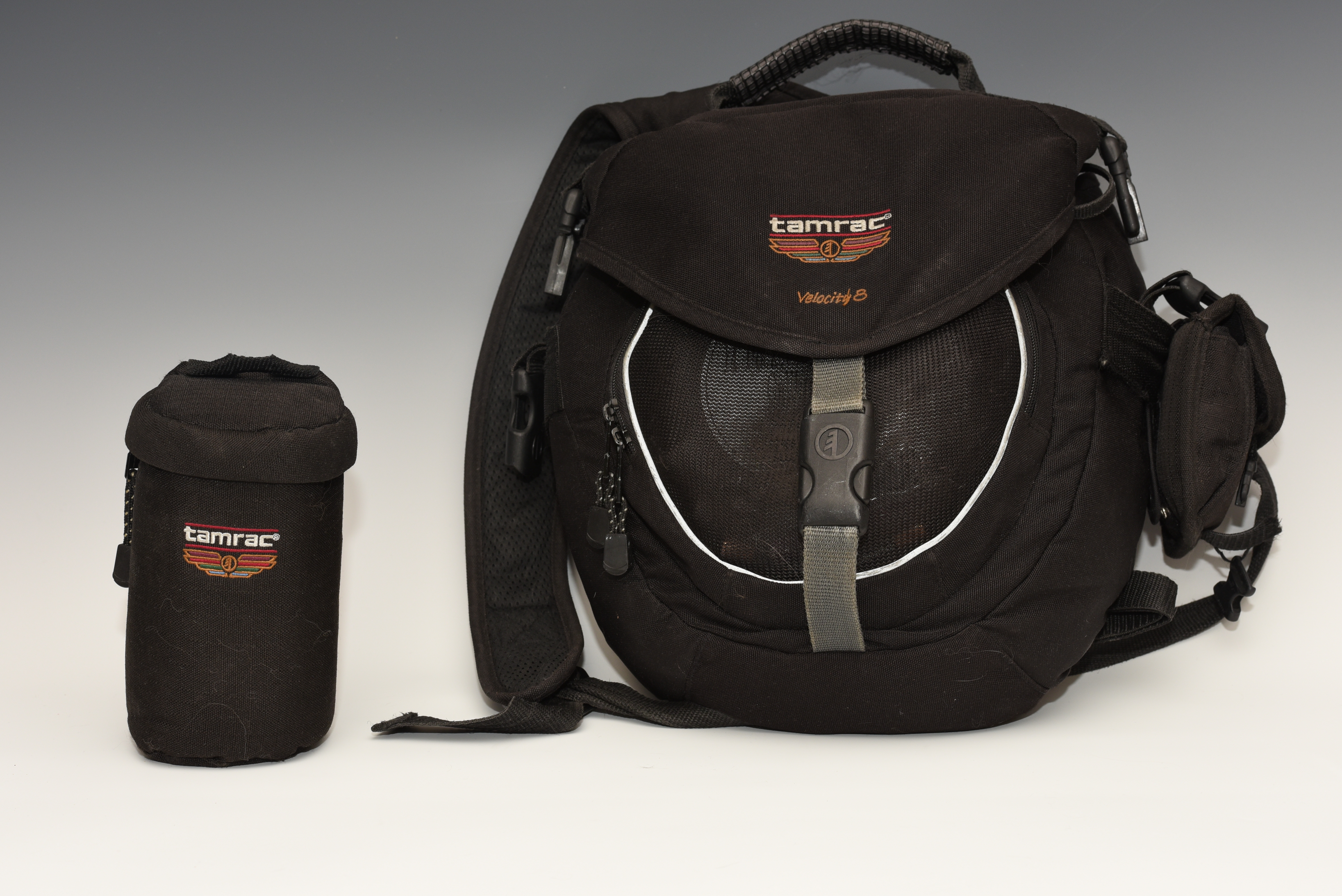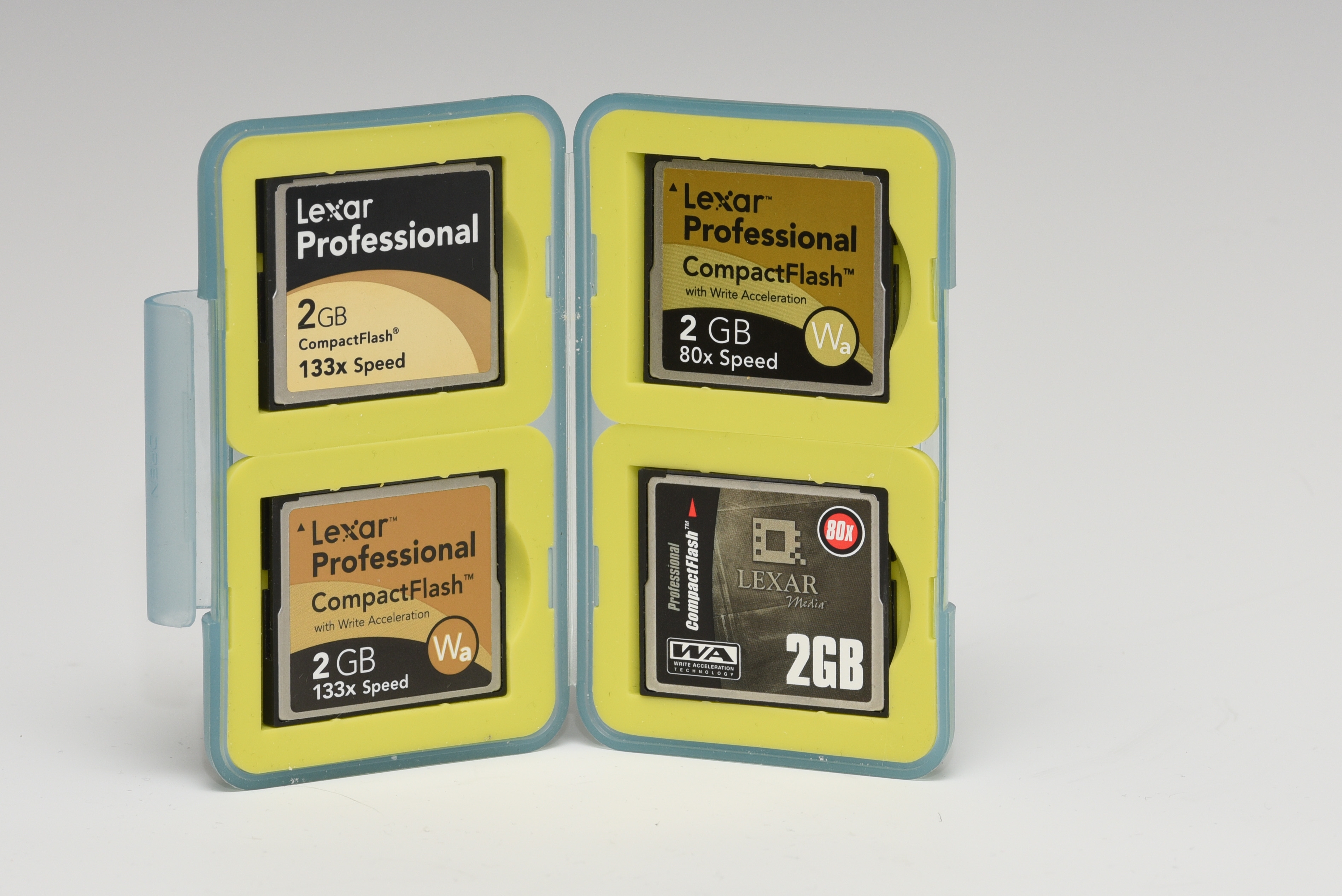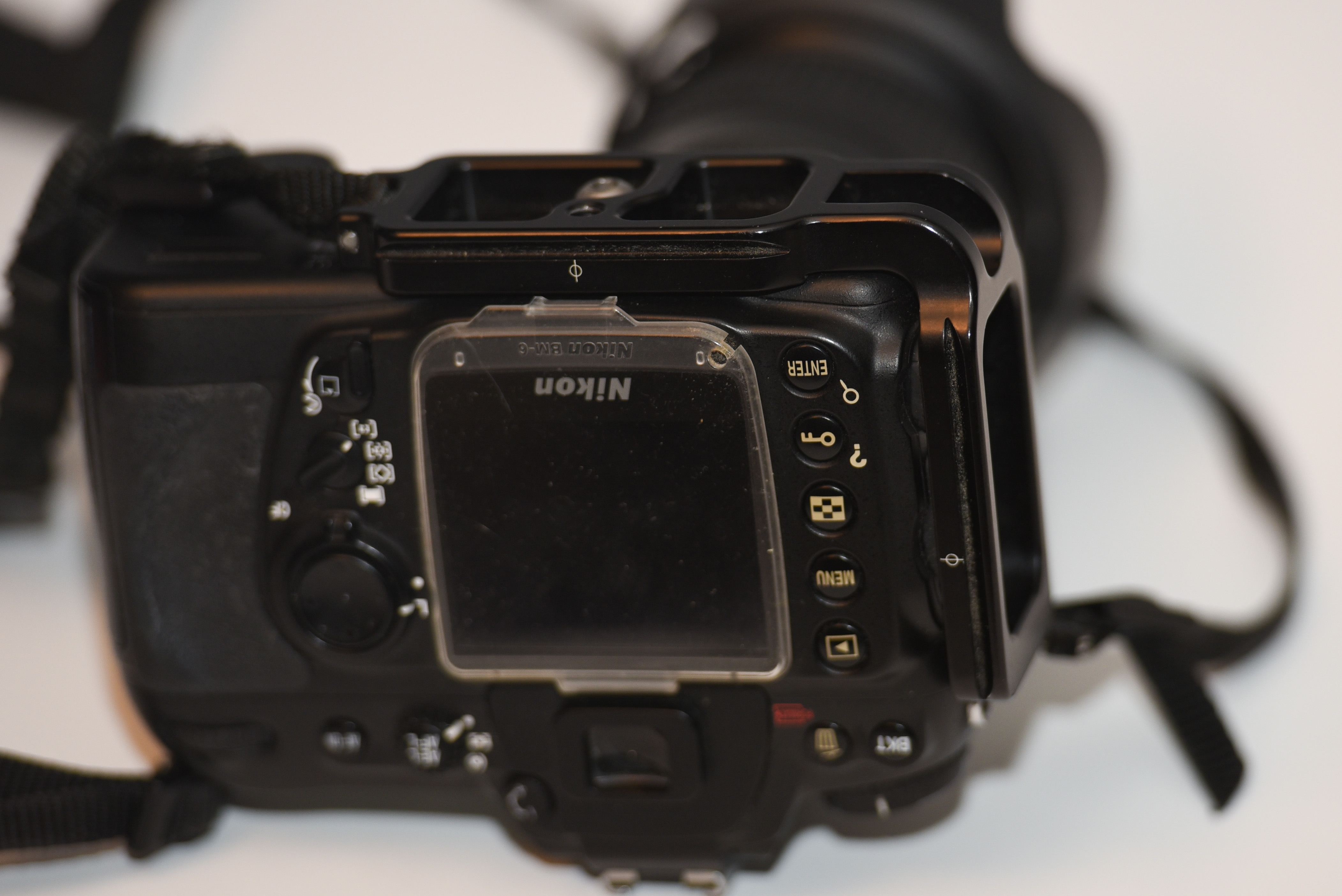Original photography has been a part of this blog for almost ten years. If you’ve met me in real life, then probably at some point you’ve seem me carrying around my camera bag. I thought some of my readers — especially other amateur photographers interested in the kind of photos I take — might find it interesting to see what I’ve been carrying around all that time.
The bag itself is a Tamrac Velocity 8 sling bag. I like it because I can throw it over my shoulder for easy carrying, but when I need to get something out of it, I can swing it around to the front and it hangs with the top up for easy access. I tried a few other solutions, but this was the one that has worked best for me, and I’ve been happy with it for years. It’s out of production now, but Tamrac appears to have replaced it with an updated model.
The bag has side mounting straps for accessories, and you can see a small filter bag mounted on the right. I also sometimes bring a spare lens bag, shown separately on the left here.
Inside the main bag, the one indispensable part of my day kit sits right on top:
That’s a Nikon D200 DSLR. It has a DX-size imaging sensor, which is about the size of a small postage stamp. It’s about 1/3 smaller than the FX-sized sensor, which is the size of a traditional frame of 35-mm film, but it’s several times larger than the sensor in the compact point-and-shoot camera I upgraded from, and much larger than the sensor in my iPhone. The sensor is 10 megapixels, which isn’t much by today’s standards — compact cameras have 12 to 20 MP, and the new iPhones are 8MP — but it was pretty good at the time, and the larger pixels allow each photosite to collect more light, which makes the sensor more sensitive than a compact camera and better able to take photos in low light. Also, for the kinds of shooting I do, 10 MP is more than enough.
The D200 was what’s sometimes called a “prosumer” camera — filling the gap between the entry-level DSLR cameras and the high-end professional gear. Generally speaking, the more professional cameras don’t produce better pictures, but they allow photographers to get good pictures in a broader range of conditions. Among other things, they operate more quickly allowing photographers to time photos better, and since everything that moves under electric power involves magnets, faster cameras have bigger magnets, mostly in motors, meaning professional cameras are heavier. They’re also more durable, with weather sealing and hard metal cases, adding to the weight. The D200 was not Nikon’s largest camera, but it’s pretty hefty.
You might think all those buttons would be intimidating, but they’re just another way to speed up photography. Most of them don’t do anything you can’t do with all but the cheapest cameras, but when I want to change a setting, I just push a button and turn a dial instead of hunting through several layers of menus. Not that the D200 doesn’t have a lot of menus for customization. If a photographer knows he’s going to be shooting one kind of photo for a while, he can set the camera up to make it easier and faster.
Although DSLR cameras allow you to swap lenses, I took almost all of my photos with the lens you see here, Nikon’s AF-S 18-200mm f/3.5-5.6 G ED VR lens. It’s not a high-quality pro lens, but it sure has a versatile focal length — it’s a “street zoom,” intended for unplanned photography where you might take wide shots and telephoto shots one after another, and it would be inconvenient to change lenses. It does occasionally creep the focal length in and out from the weight of the elements when I tilt it far off the horizontal. Nevertheless, I’ve really put it to work, and if you want a great all-in-one lens for DX format, I highly recommend it. I’ve heard that the modern version is just as good, and it fixes the lens creep problem.
This photo also shows my Op/Tech Pro neck strap and a separate Tamrac hand strap. I’m paranoid about fumbling the camera. It’s tough, but a 4- or 5-foot drop onto concrete would probably break it.
All those big motors and fancy electronics use a lot of power, so I keep several recently charged Nikon EN-EL3 batteries in the bag. I see one of these is actually a knock-off battery from the late great ill-fated Calumet Photographic. They were located in Chicago, and I live a few miles from their Cherry Avenue store.
I also carry a pack of memory cards, in addition to the one that’s always in the camera. At the time, professional photographers overwhelmingly used the Compact Flash format cards, which are rather large. I didn’t think to put something in there for scale, but to give you an idea, the folded-up case is just a little smaller than an iPhone 4.
These cards are made by Lexar, which at the time was considered one of the few brands reliable enough for professional photographers. Note that each card was a whopping 2 Gigabytes. Shooting high quality JPEGs, I could put about 425 images on each one, and I have on occasion filled all of them (burning through several batteries in the process). Cards that small are dirt cheap these days, but you don’t want to know how much I paid back then.
Next to the camera and lens, the most important item in my kit is the external flash, a Nikon SB-800 speedlight. I almost never use the camera’s built-in flash. It’s comparatively weak, and since it’s located so close to the lens it tends to flatten images and when shooting people it exacerbates red eye. Having the flash head a little higher seems to help. The head also tilts and swivels, allowing me to bounce light off parts of the room to light the subject broadly from an angle that makes the 3D shape stand out more in a 2D image.
Like all of Nikon’s modern flash units, the SB-800 participates in the Creative Lighting System, which means that the units can be controlled remotely by other flash units, including the built-in flash on Nikon cameras. When configured correctly, they participate in Through-The-Lens metering and can be programmed to provide different levels of exposure in the image. I have a few more of these speedlights that I can bring along in a separate bag if I need to.
The flash is pictured here with its built-in bounce card extended. The bounce card is handy when I’m photographing a person and I’m bouncing the light off the ceiling. It catches some of the light right at the flash head and throws it directly at the subject, giving their eyes a bit of a sparkle.
Also in the picture is the diffusion dome, which can be used to scatter light around the room, so the subject picks up natural looking light from all directions.
The flash uses a lot of power, so I always carry emergency batteries that will allow me to keep shooting if I use up the batteries inside. Although these are Alkaline batteries, I normally operate the flash on rechargeable batteries to keep costs down. I use Alkaline batteries as spares, however, because the rechargeable battery chemistry of the day did not allow for batteries that could keep their charge for months of sitting in a camera bag.
The bulge on the left is an attachment to hold a fifth battery, which makes the speedlight capacitor charge faster between flashes, at the expense of bulk and weight. I can’t help noticing, however, that the number of batteries I’ve been carry around lately is not a multiple of 5.
I also carry a stand for the flash in case I want to set it up somewhere and trigger it remotely from the camera. I almost never do that with this unit, although I do sometime use additional standing flash units to add more light.
I also carry a folding miniature LumiQuest soft box to soften the harsh shadows caused by direct flash. It greatly reduces the distance at which the flash is effective, so I only use it in special cases.
I carry around this cable so I can take the flash off the hot shoe on the camera. I mostly use it with the flash bracket (coming next), but I can also use it to hand-hold the flash further away from the camera.
Here are the parts of the flash bracket assembly, consisting of the round flash bracket itself, the orbiting tilt mount used to hold the flash, and the nodal slide rail used to mount the bracket to the camera. Disassembled like this, the bracket ring fits in the side pocket of the bag, and the other two parts fit into one of the internal compartments.
That photo shows the L-bracket I keep permanently attached to the bottom of my camera. I can use it to quickly mount the camera in my tripod, but most of the time it serves as a place to attach the flash bracket, as seen in the next shot.
Here’s the complete flash bracket attached to the camera and ready for shooting. At the very least, it raises the flash up a bit more, which reduces red eye and throws the subject’s shadow further down behind them, where it’s less visible. But it also allows me to rotate the camera to portrait orientation while still keeping the flash above the camera:
This bracket is especially helpful when I want to bounce the flash off the ceiling, because it allows me to quickly rotate the camera between landscape and portrait orientation while keeping the flash head aimed in the right direction.
As I said, I rarely switch lenses, but I do sometimes clip on my extra lens bag to carry this trick lens that allows me to take super-wide-angle pictures. Because of that, I wasn’t too concerned with the quality of the image — it’s necessarily distorted by the nature of fisheye lenses — so I saved myself a bunch of money and bought this Sigma 10-20 mm D f/4-5.6 instead of a more expensive Nikon lens. It’s worked out just fine.
If I’m bringing the extra lens bag (the weight hanging off the side throws off the balance of the bag more than you’d think, or I’d carry it all the time) I usually also throw in one of my two cheap fast prime lenses. These only have a single focal length — they don’t zoom — but they have a larger aperture so the can work in much less light without a flash. Usually I take the 35mm f/2 D, which has a very natural look with a DX sensor, but the 50mm f/1.4 D is also nice.
I bought these lenses new, but they’re based on a design that is almost 25 years old, so they might not produce quite the high-quality images a modern lens does. They are both, however, awesome for the price. The pro-glass Nikon 35mm f/1.4 G prime is $1600, which is more than twice what I paid to get both of these lenses.
Inside the external filter pack I have three filters. I don’t carry color adjustment or special effects filters, because in most cases I could do the same thing in Photoshop or Lightroom. I carry filters for things that can’t be done in post.
On the left is a polarizing filter. Light reflecting off of shiny surfaces is polarized, so by rotating this filter to match the polarization of the reflected light, I can reduce glare. That’s nice when shooting water or shiny metal objects, but even things you wouldn’t think of as shiny, such as leaves and flowers, often have a subtle amount of glare. Since glare generally doesn’t pick up the color of the surface it reflects from, it tends to wash out colors in images. A polarizing filter puts it back, at the cost of absorbing some of the light, requiring more exposure. Polarization is not recorded by a camera sensor, so I’d have no way to remove it in post. It has to be done at the time the image is captured.
The standing filter is a neutral graduated filter, shading into darkness on the top end. I got it when I was shooting landscapes so I could keep the sky from washing out. It’s turned out to be a little weak, and if I do more of that kind of shooting, I’ll probably want to get one that darkens the upper half more. I could darken the sky in Photoshop, but if the sky is completely washed out, there’s no color information for Photoshop to recover, so I have to use a filter to keep the sky color.
The bottom filter is a neutral density filter, which simply reduces the amount of light getting in the lens for any given aperture. I got it because…well, to be honest, I don’t remember. I must have had an application. There must have been something I wanted to shoot in bright daylight with the aperture wide open for dramatic effect, and I wanted the exposure to be long enough to get some motion blur. Since this is all about camera operation, Photoshop can’t help, so I’d need this filter.
My main 18-200 lens has a 72mm filter ring, but I have an adapter so I can use 77mm filters, which is a standard size. You can see the adapter attached to the polarizing filter.
I also keep this mini-tripod in the case. It’s come in hand a few times when I wanted to take a steady shot (or a selfie) and didn’t have my main tripod.
This was an infrared remote that I got for use with the tripod, so I could easily include myself in group pictures or avoid touching the camera to trigger the shutter. Unfortunately it doesn’t seem to work from more than a few feet from the camera, even indoors. It’s basically useless, and I shouldn’t have been carrying it around so long.
This is a dual-use item from PhotoVision that I use for shooting in natural light. On one side, it’s an exposure and white balance calibration target I can put into a scene when I want an accurate read of the light temperature. (Although I have my doubts that that’s really 18% grey in the center like it’s supposed to be.) On the other side, it’s a reflective panel that I can use to fill in shadows on sunlit scenes. I haven’t used it much lately.
This is for cleaning the DSLR sensor in the field. Just squeeze to get a gentle stream of air. It seemed like a good idea, but I never use it. For one thing, since my main lens is so versatile, I hardly ever swap lenses, so there’s little chance for dust to get in. Also, I rarely review images on a computer in the field, and the monitor on the back of the camera is too small for dust specs to show up unless I zoom in to look for them, so I don’t ever notice dust on the sensor until I get it back home. And at that point I can use a proper cleaning kit on the sensor.
The Compact Flash memory card format is so old that nothing else supports it. I use an adapter at home, but if I want to get images off the camera in the field, I have to use a USB cable connecting the camera to a PC.
That’s about it. About 90% of all the photos I’ve taken with this camera required nothing more than the gear in this bag.
If any of you have suggestions, or want to tell me about photographic gear you find useful enough to keep with you all the time, I’d love to hear about it.
























Leave a Reply